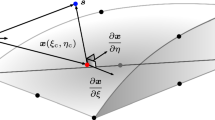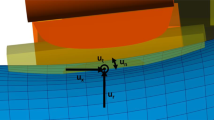Abstract
Stresses in gear contact simulations, performed using elastic multibody systems, are recovered. A single gear pair is used for stress investigations and an impact is chosen as simulation case representing an extremely dynamical situation. The gears are modeled as a reduced elastic multibody system allowing a fast computation of the dynamical problem. Depending on the projection matrix which is used for model order reduction, stresses can sometimes not be recovered accurately throughout the whole gear. Thus, the main focus in this paper lies on the selection of the functions which make up the projection matrix and, therefore, determine the elastic deformations and the quality of recovered stresses. However, the chosen set of modes does not only affect stress calculation, it also strongly affects the computation of the dynamics of the gear system and, thus, the computational effort, and may lead to serious drawbacks. This issue is discussed, too. Upon that, several different mode sets are analyzed trying to minimize the computational effort of the elastic multibody system for the given problem while still being able to recover accurate stress values on distinct geometric areas. The stress values are compared with a finite element reference computation. The novel contribution of this paper is the determination of a minimal set of modes including ones assigned to the nodes of the gear contact surface, which are able to accurately recover stresses but minimize the numerical drawbacks.





















Similar content being viewed by others
References
DIN 3990-1 (1987) Tragfähigkeitsberechnung von Stirnrädern, Teil 1: Einführung und allgemeine Einflussfaktoren (in German). Beuth Verlag, Berlin
ISO 281 (2010) Rolling bearings: dynamic load ratings and rating life, Deutsches Institut for Normung
Schiehlen W, Eberhard P (2014) Applied dynamics. Springer, Berlin
Shabana AA (2005) Dynamics of multibody systems. Cambridge University Press, New York
Wittenburg J (1977) Dynamics of systems of rigid bodies. Teubner, Stuttgart
Helsen J, Vanhollebeke F, Marrant B, Vandepitte D, Desmet W (2011) Multibody modelling of varying complexity for modal behaviour analysis of wind turbine gearboxes. J Renew Energy 36(11):3098–3113
Walt M, Butterfield S, McNiff B (2007) Improving wind turbine gearbox reliability. In: European wind energy Cconference, Milan, Italy
Simpack. http://www.simpack.com. Accessed on 3 Feb 2017
Zienkiewicz OC, Taylor RL, Zhu JZ (2013) The finite element method: its basis & fundamentals, 7th edn. Butterworth-Heinemann, Oxford
Cook RD, Malkus DS, Plesha ME, Witt RJ (2002) Concepts and applications of finite element analysis. Wiley, New York
Wriggers P (2002) Computational contact mechanics. Wiley, Chichester
Chang SH, Huston RL (1983) A finite element stress analysis of spur gears including fillet radii and rim thickness effects. J Mech Transm Autom Des 105(3):327–330
Reddy S, Handschuh R (1995) Contact stress analysis of spiral bevel gears using finite element analysis. J Mech Des 117:235–240
Chen YC, Tsay CB (2002) Stress analysis of a helical gear set with localized bearing contact. Finite Elem Anal Des 38(8):707–723
Lin T, Ou H, Li R (2007) A finite element method for 3D static and dynamic contact/impact analysis of gear drives. Comput Methods Appl Mech Eng 196(9):1716–1728
Schwertassek R, Wallrapp O (1999) Dynamik flexibler Mehrkörpersysteme (in German). Vieweg, Braunschweig
Shabana AA (1997) Flexible multibody dynamics: review of past and recent developments. Multibody Syst Dyn 1(2):189–222
Tobias C, Eberhard P (2011) Stress recovery with Krylov-subspaces in reduced elastic multibody systems. Multibody Syst Dyn 25(4):377–393
Wilde RA (1976) Failure in gears and related machine components. In: Mechanical failure, definition of the problem: proceedings of the 20th meeting of the mechanical failures prevention group, held at the National Bureau of standards, Washington, DC, May 8–10, 1974. No. 423. US Dept. of Commerce, National Bureau of Standards: for sale by the Supt. of Docs., US Govt. Print. Off
Balmforth N, Watson HJ (1964) A practical look at gear-tooth damage. In: Proceedings of the institution of mechanical engineers, conference proceedings, vol 179, no. 4, Paper 16, SAGE Publications, London
Ku PM (1976) Gear failure modes—importance of lubrication and mechanics. ASLE Trans 19(3):239–249
Amzallag C, Gerey J, Robert J, Bahaud J (1994) Standardization of the rainflow counting method for fatigue analysis. Int J Fatigue 16(4):287–293
Tobias C (2012) Schädigungsberechnung in elastischen Mehrkörpersystemen (in German). Dissertation, Schriften aus dem Institut für Technische und Numerische Mechanik der Universität Stuttgart, vol 24, Shaker, Aachen
Ziegler P, Eberhard P (2009) An elastic multibody model for the simulation of impacts on gear wheels. In: Arczewski K, Fraczek J, Wojtyra M (eds) Proceedings multibody dynamics 2009—ECCOMAS thematic conferences, Warsaw
Guyan RJ (1965) Reduction of stiffness and mass matrices. AIAA J 3(2):380
Craig R (2000) Coupling of substructures for dynamic analyses: an overview. In: Proceedings of the AIAA dynamics specialists conference, Atlanta
Maia N, Silva J (1997) Theoretical and experimental modal analysis. Research Studies Press, Baldock
Ericson TM, Parker RG (2013) Planetary gear modal vibration experiments and correlation against lumped-parameter and finite element models. J Sound Vib 332(9):2350–2375
Kahraman A, Singh R (1990) Non-linear dynamics of a spur gear pair. J Sound Vib 142(1):49–75
Fehr J (2011) Automated and error-controlled model reduction in elastic multibody systems. Dissertation, Schriften aus dem Institut für Technische und Numerische Mechanik der Universität Stuttgart, vol 21, Shaker, Aachen
Bathe K-J (1996) Finite element procedures. Prentice-Hall, Upper Saddle River
ANSYS INC (2014) Documentation for Ansys, Release 15. Canonsburg
SIMULIA (2013) Abaqus Theory Manual. Abaqus, Inc
Ziegler P (2012) Dynamische Simulation von Zahnradkontakten mit elastischen Modellen (in German). Dissertation, Schriften aus dem Institut für Technische und Numerische Mechanik der Universität Stuttgart, Band 23, Shaker Verlag, Aachen
Dietz S, Knothe K (1997) Reduktion der Anzahl der Freiheitsgrade in Finite-Elemente-Substrukturen (in German), ILR Mitteilung 315. Institut für Luft- und Raumfahrt, Technische Universität, Berlin
Dietz S (1999) Vibration and fatigue analysis of vehicle systems using component modes. Dissertation, VDI Fortschritt-Berichte, Reihe 12, Nr. 401, VDI-Verlag, Düsseldorf
Rubin S (1975) Improved component-mode representation for structural dynamic analysis. AIAA J 13(8):995–1006
Craig R, Bampton M (1968) Coupling of substructures for dynamic analyses. AIAA J 6(7):1313–1319
Allgöwer F (2000) Robuste Regelung—Teil 1 (in German). In: Lecture notes, University of Stuttgart
Salimbahrami SB (2005) Structure preserving order reduction of large scale second order models. Dissertation, Technische Universität München
Author information
Authors and Affiliations
Corresponding author
Rights and permissions
About this article
Cite this article
Schurr, D., Holzwarth, P. & Eberhard, P. Investigation of dynamic stress recovery in elastic gear simulations using different reduction techniques. Comput Mech 62, 439–456 (2018). https://doi.org/10.1007/s00466-017-1507-z
Received:
Accepted:
Published:
Issue Date:
DOI: https://doi.org/10.1007/s00466-017-1507-z




